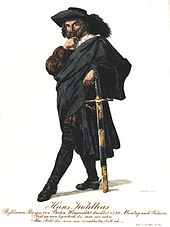- Michael Kohlhaas
-
Michael Kohlhaas is an 1811 novella by Heinrich von Kleist, based on a 16th-century story of Hans Kohlhase.
Both the theme (a fanatical quest for justice) and the style (existentialist detachment posing as a chronicle) are surprisingly modern. They resonated with other writers more than a century after they were written.
Contents
The historical Kohlhase
The merchant Hans Kohlhase lived in Cölln on the Spree (now incorporated into Berlin) in the Margraviate of Brandenburg in the 16th century. In October 1532 he set out on a trip to the Leipzig trade fair in the neighboring Electorate of Saxony. On the way two of his horses were seized, at the command of the Junker von Zaschwitz, as a supposed fee for passage through Saxony. Kohlhase sought redress in the Saxon courts but failed to obtain it. Outraged, he issued a public challenge in 1534 and burned down houses in Wittenberg. Even a letter of admonition from Martin Luther could not dissuade him, and Kohlhase and the band he collected committed further acts of terror. In 1540 he was finally captured and tried, and was publicly broken on the wheel in Berlin on 22 March 1540. From this history Kleist fashioned a novella that dramatized a personal quest for justice in defiance of the claims of the general law and the community.
Political background
In the early 19th century, defeats in the war against Napoleon and unsettled domestic conditions (as the rulers of German kingdoms and principalities pursued various strategies of accommodation with Napoleon) contributed to a mood of dissatisfaction in Prussia.
Kleist clearly opposed France and was committed to the need for reform. He could express his political ideals through the character of Kohlhaas, without thereby making himself suspect of political agitation.
Plot summary
The Brandenburg horse dealer Michael Kohlhaas is leading a team of horses in the direction of Saxony when an official of Junker Wenzel von Tronka detains him, claiming that he does not have proper transit papers. The official demands that Kohlhaas leave two horses as collateral.
In Dresden (Saxony) Kohlhaas discovers that this collateral was totally arbitrary, and proceeds to demand return of his horses. When he arrives at the castle of Junker Tronka he discovers that the horses have been suffering from working in the fields and his hired man, who protested against the mistreatment of the horses, has been beaten.
Kohlhaas sues the Junker for the cost of medical treatment of his hired man and for rehabilitation of his horses. After one year he finds that the suit was turned down through political influence of the Junker's relatives.
Kohlhaas persists in demanding his rights. In spite of support of a friendly politician and personal engagement of his wife (who is struck down by a guard in her attempt to deliver a petition to the Governor of Saxony and later dies of her injuries), he remains unsuccessful.
Since the administrative "old boys' club" prevents any progress through legal channels, Kohlhaas resorts to criminal means. He begins a private war. Together with seven men he destroys the castle of the Junker, who in the meantime has fled to Wittenberg. Kohlhaas frees his horses, but then ditches them in the castle in order to lead his growing "army" (really a mob) to Wittenberg, demanding the Junker. In spite of numerous attacks of his 400-man army on Wittenberg he fails to secure the Junker.
Through personal intervention of Martin Luther an amnesty is arranged, whereby the Governor (Kurfürst of Saxony) approves the suit against the Squire. But the Junker again activates his influential family and Kohlhaas is thrown into a dungeon in Brandenburg.
The Governor of Brandenburg manages to have Kohlhaas released, but since in the meantime Saxony has informed the Kaiser in Vienna, the ruling families in Berlin feel this threat to the authority of the aristocracy must be handled with severity. In spite of surprising efforts of the Governor of Brandenburg to save Kohlhaas, he is sentenced to death. Later it turns out that Kohlhaas has on his person papers that contain important information about the House of Saxony.
As Kohlhaas is led to execution, he sees in the crowd the disguised Governor of Saxony. Through his lawyer, he's informed that his suit against the Junker has been successful, and is presented with compensation for the injuries of his hired man and shown the horses, now well-fed and healthy. Pleased that justice has been served, he submits willingly to the execution. However, shortly before being beheaded, he opens the amulet on his neck containing the papers regarding the House of Saxony and swallows them. The Governor of Saxony is so distressed by this act that he faints, and Kohlhaas is beheaded shortly thereafter.
Influence
Kafka devoted one of only two public appearances in his whole life to reading passages from Michael Kohlhaas. Kafka said that he "could not even think of" this work "without being moved to tears and enthusiasm."[1]
The story had an influence on E. L. Doctorow's 1975 novel Ragtime, which uses similar plot elements and has a protagonist named "Coalhouse Walker". Doctorow himself called his book "a quite deliberate hommage" to Kleist's story.[2]
The 1999 film The Jack Bull was loosely based on this book.
References
- ^ Clark Sterne, Richard. (1994) Dark Mirror: Sense of Injustice in Modern European and American Literature, Fordham University Press. p. 180.
- ^ Doctorow, E. L., and Morris, Christopher D. (1999) Conversations with E.L. Doctorow University Press of Mississippi. p. 124.
External links
- (English)"Michael Kohlhaas" in The German Classics: Masterpieces of German Literature Translated into English, Vol.4 (c.1914), page 308. Translated by Frances H. King. (see also Project Gutenberg version).
- (English)"Michael Kohlhaas" in Tales from the German, Comprising Specimens from the Most Celebrated Authors (1844), page 165. Translated by John Oxenford and C.A. Feiling.
Categories:- 1811 short stories
- Short stories by Heinrich von Kleist
Wikimedia Foundation. 2010.

